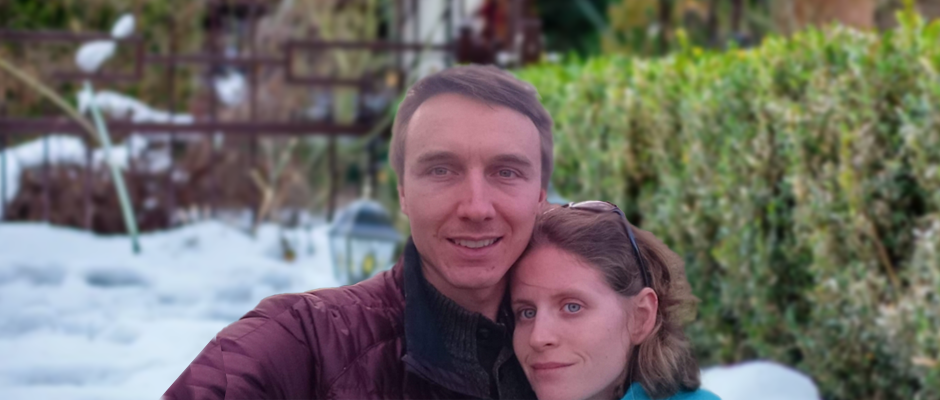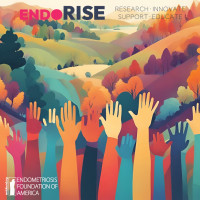
December 24, 2015 should have been extraordinary. The sun glowed over dense evergreen trees and serenity blanketed the Black Forest. My husband and I were staying on a German farm for Christmas where cats, dogs, horses, and other livestock greeted us the moment we walked out our front door. I had spent most of my adult life working toward a career as a history professor, specializing in German History. And after years of studying and teaching, I could not wait to hike and explore that tranquil, southwest corner of Germany. Moreover, my husband and I had laid plans to visit the town of Freiburg and cross the Rhein River into France. What a Christmas Eve it should have been!
But at 6:00 a.m., December 24, I woke up with acute abdominal cramping. I sighed. The morning was indeed extraordinary. Extraordinarily familiar. Twisting, pulling, acute pain spread through my pelvis, lower back, and right leg to my knee. It was the same story every four weeks. The experience I’d known since I was fifteen but had kept private because I assumed every woman experienced the same symptoms. It had always just seemed normal. And over the years, I just established it was “bad period cramps,” and adopted a regime of taking four ibuprofen every eight hours for the first two-four days of my period.
After taking the ibuprofen that morning, I crawled back into bed. But not for long. For the third time in four months, unique and disabling pain returned. I couldn’t speak. My stomach churned from the pain until at last, I scrambled to the bathroom and threw up. Half an hour later, I sat in a shower that could not get hot enough. Then I looked in the mirror and saw a ghostly caricature of myself. Several hours later, I pulled myself out of bed, the ibuprofen having taken the edge off my pain. A single thought ran through my mind: “I may never get to see Freiburg again.” I could not miss it. But I slept in the car as we drove the hour into town. Later, I fell asleep with my head on a table inside Freiburg’s food court, indescribable fatigue having taken its toll. By late afternoon, we crossed the border into France. My first and only visit to France, I forced myself to smile when we took a photo near the Rhine River. That evening, instead of reveling in the experience of a European Christmas Eve, I lay balled up in a bed, longing for my heat pad and stronger medicine than ibuprofen. That was the moment I knew—and finally admitted to myself—that something was wrong. For the first time, I said a phrase that had chased my subconscious for years: “I have endometriosis.”
A month later, I visited a long-time fertility specialist and endometriosis expert in Knoxville, Tennessee. He was a skilled surgeon who had been the first to realize that I had developed mild ovarian cysts in my early twenties. When I presented him with what happened in Germany, he said, “Alison, I think you have endometriosis.” A part of me was shocked to hear it said aloud. No other woman in my family had any kind of reproductive illness. But part of me realized he was stating what I already suspected. What horrified me more was his next declaration: “You may have a hard time getting and staying pregnant.” At 29, I’d been married for years, and we both wanted kids. My doctor, seeing my distress, suggested a laparoscopy and hysteroscopy to hunt for endometriosis.
My first laparoscopy in mid-February of 2016 confirmed I had endometriosis. But, to my doctor’s surprise, not too much. Although he assured me that endometriosis was complex, and that the amount had little to do with the pain, I was still surprised to learn I only had mild endometriosis. In my head, I could not reconcile that fact with the levels of pain I experienced. Still, my doctor suggested that my husband and I consider making children a priority if we wanted to have them before endometriosis returned.
I became pregnant with our first daughter in spring 2016. But from the outset, it was a very hard pregnancy fraught with continual nausea, vomiting, and inexplicable bleeding. At one point, I knew I must have had a miscarriage. An emergency visit to my doctor’s office occurred that afternoon, and amazingly, the ultrasound and bloodwork confirmed I was still pregnant. But when my doctor saw the ultrasound image, he pointed first to the live baby, then to the blood in my uterus, and said, “I can’t rule out that you may have started with twins.” I cried often during that pregnancy; I felt frightened and blamed endometriosis (rightfully or not) for my difficult pregnancy.
By luck or fate, our first, healthy daughter was born late in the year. When she turned nine months old, I slowed down breastfeeding. Immediately my period cramps returned with furious vengeance, as if someone had flipped an “on” switch. Severe cramping occurred across my pelvis, lower back, and down into my right leg. My doctor prescribed a half dozen birth control options over the succeeding months. Every one of them made me throw up daily for weeks on end—far longer than was considered within the range of “normal.” And my cramps remained intense. Surprisingly so, since I apparently had had my endometriosis removed only a year before. But try as we did, I could never find a hormonal treatment that my body would tolerate. Knowing that I wanted a second child, I gave up on hormonal birth control. I became pregnant a second time.
My second pregnancy ended in sorrow. I miscarried at six weeks. Before that experience, I’d never understood the profound loss a miscarriage inflicts on a mother. But for weeks after mine, I felt empty, even when holding my toddling daughter. After all, I’d seen my second baby’s heart beating on ultrasound at five weeks. I had imagined names and dreamed of what that child would be like. A week and a half later, there was nothing. Worse still was the knowledge that having been through one documented miscarriage, my doctor was right: I realized that I had probably started out with twins in my first pregnancy. More than ever, I blamed endometriosis, even when I realized there was no rational reason for that attribution.
I was fortunate enough to become pregnant a third time and had a healthy second daughter in late 2018. Just as it had been with my first baby, the moment my daughter quit nursing frequently, severe menstrual cramps returned. Additional rounds of hormone therapy were tried and tested, and still I found no luck. I had to either choose between severe pain four days a month, or nausea and vomiting nearly every morning. Frustrated, I scheduled a second laparoscopy and hysteroscopy in fall 2020 with my excision specialist. Maybe this time, we would find answers.
To my dismay, my surgeon saw almost nothing. Minimal endometriosis growth and scar tissue. He had known what to look for, and where. Instead of celebrating the lack of new endo growth, I felt concerned and disheartened. I knew this was not the end of the story.
Within two months, my period pain returned as strong as it had in Germany. I went back to relying on heat pads, scorching showers, and constant ibuprofen and Tylenol. At that point, I began to wonder if it was all in my head. After all, my surgeon had found very little. Was it possible that I still had an invisible illness? Or did I only think I did? These thoughts frequently came to mind. And they affected me emotionally and psychologically. Only I could see or feel that sickness. I tried to brush it aside. To ignore it, repress and forget it. If I tried hard enough to block my symptoms, I thought, it would go away. I could just push through. On good days, I was very active with my daughters. I enjoyed being outside and hiking, gardening, and playing. But on my bad days, my pain did nothing but escalate and disable me.
The final tipping point came in late May, 2021. I’d had bad periods, bad pain during ovulation, nausea with pain, and a host of other symptoms. But this pain I had developed was not just my typical “bad” period. I felt as though an organ had ruptured. I slumped to the floor while my two young daughters played around me. My oldest looked at me wide-eyed and concerned as I lay in a ball on our living room floor, only able to concentrate on breathing. Somehow, perhaps through years of practicing just “slogging through,” I got up off the floor.
For the next eight months, fatigue and severe abdominal pain chased me. Not only during my period, but during ovulation, too. On top of it all, it seemed I had a permanent UTI. When I met with my doctor again, he ruled out endometriosis, having seen minimal growth the previous year. Because of my bladder pain, he suspected interstitial cystitis and referred me to a bladder and pelvic/reproductive specialist. After a brutal diet regime, and multiple tests, my new doctor ruled out IC. Instead, he said, “I think you have adenomyosis. And probably some endo, also.”
I blinked. I’d only just barely heard of adenomyosis. I knew it was a disease similar to endometriosis, and often found with it, but unlike endometriosis, it was located within the uterus itself. But I found very little agreed-upon information about it. It seemed like a mystery disease, despite how common it is believed to be. Some estimates said perhaps one and three women had it, but that not every woman displayed symptoms, while some had disabling pain. Other information suggested the disease affected mostly women in their 40s and 50s, but not young women. Certainly not teenagers, which was when I first experienced severe menstrual cramps. I looked at my doctor and said, “I don’t think it could be adenomyosis. I don’t have that severe bleeding that usually goes along with it.” I had read that women who have adenomyosis often bleed profusely during their menstrual cycles. My surgeon said in response, “Patients don’t always have severe bleeding with adeno. It’s tricky. Sometimes, it can be very moderate.” This exchange helped me see something essential: with women’s reproductive illnesses, no two cases are alike. And bless my surgeon. He had the good manners to listen to and believe me, and the confidence to pursue what he believed to be the cause of my pain. With my options run dry, I scheduled a hysterectomy.
My procedure went very well. When I woke up, I learned my surgeon had indeed found endometriosis on my left ovary, a year after my last laparoscopy. My uterus and bladder walls were “glued together” with scar tissue from two c-sections. But what really was my problem? Adenomyosis. My excellent surgeon, forever one of my heroes, declared my uterus looked like a big bag of pulpy, boggy mess. I couldn’t have been more excited. After twenty years of ignoring my pain and attributing it to various other causes, I finally had my answer. Adenomyosis was my main “bad guy” and endometriosis was its supporting henchman. And while I am certain that endometriosis will challenge me again, it’s a relief to know that a hysterectomy cured my adenomyosis, as adenomyosis grows within the uterus. I can now look forward to a healthier and more active, present lifestyle.
In writing my story, I realize how lucky I am. It may have taken me two decades to understand what was causing me so much pain every four weeks. But I have had a supportive family. My husband, ever my rock since day one more than a decade ago, remains nothing but supportive and encouraging. I have had skilled specialists who always believed me. Adenomyosis is gone. And for now, endometriosis is managed. Best of all, my husband and I have two healthy, beautiful daughters. I never forget how fortunate I am. But I know that not all women are so fortunate. Many suffer endometriosis symptoms far, far worse than I ever have. Many more still struggle with finding the correct diagnosis and doctors. Sadly, many will think severe menstrual cramps are normal—just as I did during my adolescence and early twenties. Many still will not know that there is a “cousin” to endometriosis: Adenomyosis. Its symptoms produce just as significant of pain and side-effects. Too little is known about it. We don’t know what causes it, or at what point in a woman’s life it develops. Perhaps it was always the cause of my significant menstrual pain. As a mother to daughters who are at a greater risk for developing endometriosis and perhaps adenomyosis, I cannot be silent any longer. I want women of all ages and their families to know what tolls the two “invisible cousins” take. But also, to know there is hope, and there is help. Never, ever give up on either.
Alison is a history professor for a community college in Knoxville, TN and a Teaching Fellow for the Tennessee State Holocaust Commission. She has struggled with endometriosis and adenomyosis for twenty years, but has recently had successful treatment. When not working, she enjoys spending time with her family, hiking, and organic gardening.
Editor's note: Would you like to contribute to EndoStories? Click here to learn how to submit your work.
*Patient stories submitted to EndoFound.org are the views of the patient and not necessarily those of the foundation. All testimonials are from real patients, and may not reflect the typical patient’s experience, and are not intended to represent or guarantee that anyone will achieve the same or similar results.









